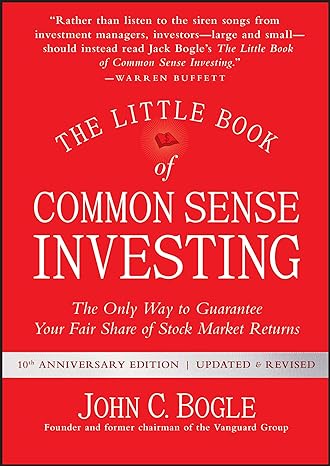Main Topic
“The Little Book of Common Sense Investing” by John C. Bogle is primarily about advocating for a passive investment strategy in the stock market, emphasizing the importance of low-cost index funds and the concept of long-term investing.
Key Ideas or Arguments
- The Virtues of Index Funds: Bogle argues that actively managed funds often underperform market indices, and investors should opt for low-cost index funds as a safer and more reliable investment option.
- The Impact of Costs: The author emphasizes the significance of minimizing investment costs, such as fees and expenses, which can significantly erode returns over time.
- Long-Term Perspective: Bogle promotes a long-term investment horizon and advises against frequent trading or market timing.
- The Folly of Speculation: He cautions against speculative behavior and advises investors to stay the course, even during market downturns.
Chapter Titles or Main Sections
- The Big Mistake: High Costs: Bogle highlights how high costs in traditional investment management can erode returns.
- The Biggest Mistake of All: This chapter discusses the challenges of consistently outperforming the market through active management.
- How Most Investors Turn a Winner’s Game into a Loser’s Game: Bogle explains how frequent trading and speculation can hinder investment success.
- The Grand Illusion: This section addresses common misconceptions about the stock market and investing.
- The Great Intellectual and Emotional Challenge: Bogle delves into the psychological aspects of investing and the importance of maintaining a disciplined approach.
- The Twelve Pillars of Wisdom: This chapter outlines twelve guiding principles for successful investing.
Key Takeaways
- The book underscores the significance of low-cost index funds as a reliable and prudent investment strategy.
- Long-term investing is advised, with a focus on minimizing costs and avoiding market timing.
- Emotional discipline and understanding the psychological challenges of investing are crucial for success.
Author’s Background and Qualifications
John C. Bogle was the founder of Vanguard Group and a pioneer in the field of passive investing. He is widely recognized as one of the most influential figures in the financial industry, known for his expertise in investment and his advocacy for the interests of individual investors.
Comparison to Other Books
Compared to other investment books, “The Little Book of Common Sense Investing” distinguishes itself by its strong endorsement of passive investing and the use of index funds. It stands in contrast to many books promoting active trading and market-beating strategies.
Target Audience
The book is primarily aimed at individual investors seeking a practical and low-risk approach to investing in the stock market. It is suitable for beginners and those looking for a long-term investment strategy.
Reception or Critical Response
The book has received widespread acclaim for its straightforward and sensible advice on investing. It is considered a classic in the field and has been praised for its wisdom and simplicity.
Publisher and First Published Date
- Publisher: John Wiley & Sons, Inc.
- First Published Date: April 28, 2007
Recommendations
- “A Random Walk Down Wall Street” by Burton G. Malkiel
- “The Bogleheads’ Guide to Investing” by Taylor Larimore
Biggest Takeaway
The most crucial takeaway from “The Little Book of Common Sense Investing” is that low-cost index funds, a long-term perspective, and emotional discipline are the keys to achieving consistent and reliable returns in the stock market.



